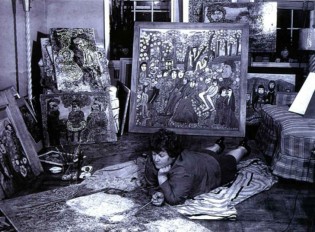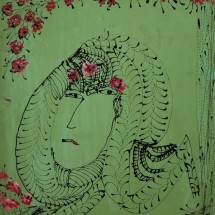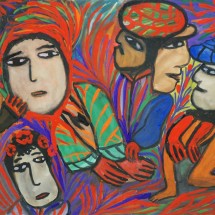Janet Sobel (American, b. Ukraine 1893–1968)

Photo courtesy of Gary Snyder Gallery
Sobel’s artwork, unlike that of many self-taught artists, was shown beside well-known, mainstream artwork during her lifetime; she was accepted inside as an outsider. Her works repeat many of the stylistic motifs that other outsider artists are attracted to, such as horror vacui, or a fear of empty spaces resulting in covering her surfaces completely. However, as an artist with a great deal of exposure to mainstream work, Sobel’s artwork also reflects many of the Surrealist philosophies regarding experimentation with style, figure, and form.
Sobel was born Jennie Lechovzky in Ukraine in 1893 and immigrated to the United States in 1908 with her mother and two siblings after her father was killed in a pogrom. In 1910, at the age of sixteen, Janet married Russian immigrant Max Sobel, whom she had known during her childhood. The couple settled in Brighton Beach, Brooklyn, and had five children. With encouragement from her son Sol, Sobel began to paint at the age of 43. Sol recognized the talent in his mother’s work and began introducing her work to such figures as Max Ernst, Marc Chagall, and John Dewey. Surrealist artists enjoyed Sobel’s early works for their unrestricted imagination, figurative abstraction, and representational qualities. Sobel’s drip paintings may have influenced Jackson Pollock, who, along with art critic Clement Greenberg, viewed Sobel’s work at Peggy Guggenheim’s famed Art of This Century gallery in 1945. Greenberg noted that Sobel’s work was the first instance of “all-over” painting—which characterized much of the work of American Abstract Expressionist painters—that he had seen. Sobel’s later works went out of fashion because of Surrealism’s evolution away from figurative abstraction into full abstraction as well as because of Sobel’s move in 1946 to Plainfield, New Jersey, away from the Surrealist influences of New York City. Sobel’s reputation lived on even after her death in 1968. Her interaction with the mainstream art world gave her works a distinctive quality: Surrealist influence within the unrestrained creativity of an outsider artist.
- Untitled, ca. 1941
- Untitled, ca. 1942
- Untitled, ca. 1942



